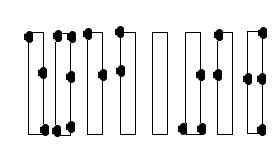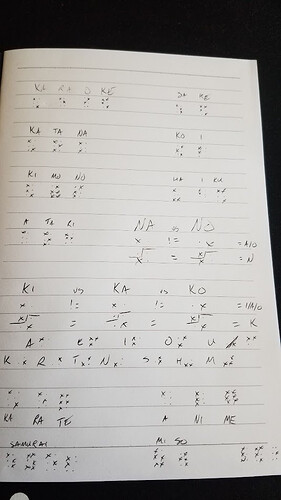k is actually lower right only, so no ku and ke are not identical ku as in hai ku is there
e is one of the most prominent marks as its top two and mid left
So how would we spell Samurai and Miso?
Im with her
let me elaborate on this, the haiku consideration is that i think as english speakers we're inclined to read it as two syllables and we naturally identify the marks as connected to syllables. ha i ku obviously makes three. so perhaps in the japanese language there is no mu as a single syllable or 'sound' as i guess these marks represent? i'm unsure, but we do have a person that could elucidate these matters.
the interesting part about samurai is that sa m u ra i seems rather lengthy vs what could just be sa mu ra i
but in the tenji me and mu would read the same because of overlap so there must be another rule about the sounds slash syllables
ah right that was the consideration for mi and ma
suggesting m i so
because mi and ma would be indistinguishable without further rules
yeah, this involves more work
lol i got it
i incorrectly identified m i'm dumb
Post the answer
Nyte is so far the closest for the tenji
I will post the full solution when someone posts the right answers
Right now I am actually sweating trying to write up a solve for the Greek

Samurai is right, Miso is almost there
What is your thinking behind miso?
I think I see your thinking in the earlier post actually, it's just the mi/ma confusion
Mi/So is 2 syllables
brainfarted
i think that's the problem with looking at things in pieces
i knew this and steamrolled my old m logic anyway

![]()
for clarity's sake
my brain can store this more peacefully now
Didn't you vote for genocide Joe?
This is just an undetermined linear system -- how can you mongs be entertained by this?
Nyte has solved Problem 1.2
Solution:
1.2
To write the new words we have to decipher the tenji language beyond basic syllables.
To do so, we can look at the differences between similar syllables such as "NA" vs "NO" or "KA" vs "KI" vs "KO"
When we do this, we notice the top left 3 dots match when the vowels are consistent and the bottom 3 match the consonants.
Using this rule, we can create a rough alphabet of the phonetic characters in the sample.
From there, we can make assumptions about new tenji such as Ni, Mu, and So.
(This is probably vaguely incorrect from an actual tenji understanding perspective but since it is a phonetic alphabet we can roughly correlate it to the not-quite-phonetic alphabet we are most familiar with.)
For more on tenji: Japanese Braille - Wikipedia
You have to solve the easy problems to get to the more challenging ones.
So far you have solved 0 problems which puts you 1 rank below Nyte.
Zero desire to "compete" with a 40 year old woman if that's what you're implying.
